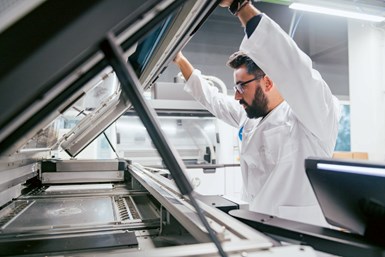HP, L’Oréal Collaborate for More Flexible Cosmetics Production
The companies are exploring ways to increase production flexibility, and create innovative packaging and customer experiences.

HP Jet Fusion 5200 under lid. Photo Credit: HP
HP is collaborating with L’Oréal, the world’s largest cosmetics company, to scale industrial additive manufacturing (AM) and explore entirely new cosmetics packaging and applications. The intent is increase production flexibility, and create innovative packaging and customer experiences.
L’Oréal turned to HP Multi Jet Fusion to quickly respond to shifts in its manufacturing processes and production lines. The companies worked together to quickly design and scale up large volumes of adjustable “pucks,” thereby enabling L’Oreal to convey, fill products and label them with better agility, resulting in a 33% cost reduction and 66% time savings.
The ability to customize the pucks has also proven valuable throughout the COVID-19 pandemic, providing L’Oréal with added agility in response to changes in consumer purchasing behaviors. L’Oréal plans to use HP’s Digital Manufacturing Network to scale the pucks across its global supply chain and meet its sustainability goals by efficiently producing the parts when and where they are needed.
The companies are also exploring the design and production of a variety of new applications that take advantage of the capabilities of HP’s Multi Jet Fusion platform. This includes the design of unique textures as well as innovative lattice packaging.
“Customer-centric innovation and sustainable products are at the center of all we do,” says Anne Debauge, L’Oréal director of digital transformation, packaging and development. “3D printing gives us this entrepreneurial freedom to offer new customer experiences. Thanks to this collaboration, we are already gaining agility in our factories and wish to go further by creating new services.”
Across large industries and new verticals such as cosmetics, HP says its customers want to be more agile and address the growing demand for personalized products. “Our work with L’Oréal is a bright example of the unlimited possibilities enabled by 3D printing,” says Guayente Sanmartin, global head of HP’s Multi Jet Fusion business. “From increasing manufacturing flexibility to reimagining traditional products, there is an enormous opportunity to help transform markets.”
Related Content
-
What Does Additive Manufacturing Readiness Look Like?
The promise of distributed manufacturing is alluring, but to get there AM first needs to master scale production. GKN Additive’s Michigan facility illustrates what the journey might look like.
-
Understanding PEKK and PEEK for 3D Printing: The Cool Parts Show Bonus
Both materials offer properties desirable for medical implants, among other applications. In this bonus episode, hear more from Oxford Performance Materials and Curiteva about how these companies are applying PEKK and PEEK, respectively.
-
3D Printed Lattices Replace Foam for Customized Helmet Padding: The Cool Parts Show #62
“Digital materials” resulting from engineered flexible polymer structures made through additive manufacturing are tunable to the application and can be tailored to the head of the wearer.













